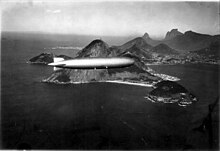Bartolomeu de Gusmão Airport
Bartolomeu de Gusmão Airport Aeroporto Bartolomeu de Gusmão | |||||||||||
|---|---|---|---|---|---|---|---|---|---|---|---|
 South door of the Zeppelin Hangar | |||||||||||
| Summary | |||||||||||
| Airport type | Public | ||||||||||
| Owner/Operator | Luftschiffbau Zeppelin | ||||||||||
| Serves | Rio de Janeiro | ||||||||||
| Opened | 26 December 1936 | ||||||||||
| Passenger services ceased | 12 February 1942 | ||||||||||
| Elevation AMSL | 3 m / 10 ft | ||||||||||
| Coordinates | 22°55′56″S 043°43′09″W / 22.93222°S 43.71917°W | ||||||||||
| Map | |||||||||||
 | |||||||||||
| Runways | |||||||||||
| |||||||||||
Sources: World Aero Data[1] | |||||||||||
Bartolomeu de Gusmão Airport (IATA: SNZ, ICAO: SBSC) was a Brazilian airport built to handle the operations with the rigid airships Graf Zeppelin and Hindenburg. The airport was named after Bartolomeu Lourenço de Gusmão (1685–1724), a Portuguese priest born in Brazil who did research about transportation with balloons.
History
[edit]
Between 1931 and 1937, Deutsche Luft Hansa had regular flights between Germany and Brazil, which were operated by Luftschiffbau Zeppelin using its rigid airships Graf Zeppelin and Hindenburg.[2] Rio de Janeiro was the final stop, where passengers could connect with aircraft services to Southern Brazil, Uruguay, Argentina, Chile and Bolivia operated by Syndicato Condor, the Brazilian subsidiary of Deutsche Luft Hansa.[3] During its five years of regular scheduled summer season intercontinental commercial airship service between Germany and South America, the hangar was used only nine times: four by the LZ-127 Graf Zeppelin and five by the LZ-129 Hindenburg.[4] Assembled from parts brought from Germany, the construction was subsidized by the Brazilian government.[5]

The airport was inaugurated on December 26, 1936 by President Getúlio Vargas, in the presence of the German Ambassador Schmidt Elskop. Before this, rigid airships were docked at Campo dos Afonsos.

The new airport consisted of an airfield, a hangar, a customs house, an office building, a radio-operations building, 5 bedrooms for workers, crew-lodgings, a work and storage house, a hydrogen factory, a plant to mix hydrogen with butane, and a branch line connecting the complex to the main railway line to downtown Rio de Janeiro 54 km away. The whole complex was built by the Luftschiffbau Zeppelin and are partially still in use by the Brazilian Air Force, which occupies the site.[6]
The hangar is an original surviving example of a structure built to accommodate rigid airships and the only Zeppelin airship hangar which remains a hangar.[7] Because of its historical importance, it was listed as a National Heritage Site on March 14, 1999.
As a consequence of the Hindenburg disaster on May 6, 1937 at Lakehurst Air Naval Station in New Jersey, US, the Luftschiffbau Zeppelin requested to the Brazilian Government on June 17, 1937 the suspension of services. After that no more civil operations were handled at this facility.
On February 12, 1942, six months before Brazil declared war against the Axis, the airport was taken over by the Brazilian Air Force Ministry and became a base of the Brazilian Air Force and therefore with exclusive military use. It is located in the neighborhood of Santa Cruz in the western region of Rio de Janeiro. The name of the facility was changed to Santa Cruz Air Force Base on January 16, 1943,[8] even though, according to a law prescribing rules for the naming of airports of July 21, 1953, the name of the facility could officially and exceptionally be maintained as Bartolomeu de Gusmão Airport.[9]
Hangar
[edit]Characteristics
[edit]The hangar has large dimensions: 274 meters long, 58 meters high, and 58 meters wide.[10] Oriented in the north/south direction, its north gate, 28 meters wide and 26 meters high served only for ventilation and exit from the mooring mast, and was opened manually. The south gate, the main one, opens to the full height of the hangar and has two parts weighing 80 tons each. These gates were opened thanks to powerful electric motors, or manually. The electrical installations were covered with shielding to prevent the occurrence of any sparks, which could cause a catastrophic fire in the airships. At the top of the hangar, at a height of 61 meters, there is a command tower, from which one can see the entire surrounding area, from Sepetiba to the Guandu River.[11]
The hangar today
[edit]
The hangar building of the Santa Cruz Air Base has been listed by the National Historic and Artistic Heritage Institute (IPHAN) since 1998 and received the listing registration #550.[12] It may be recognized by law (PL 422/2009 of the City Council of Rio de Janeiro) as one of the seven wonders of the historic neighborhood of Santa Cruz, for its touristic and socio-cultural relevance.[13]
The structure was used as one of the sets for the film For All - O Trampolim da Vitória, a 1997 Brazilian film directed by Buza Ferraz and Luiz Carlos Lacerda, which depicts the Natal Air Base in 1943. It was also shown in the documentary Senta a pua! by Erik de Castro in 1999, besides being the target of advertising campaigns and TV programs.[14] In 2009, a bill was forwarded for recognition by the City Council of Rio de Janeiro as one of the elected seven wonders of the historic neighborhood of Santa Cruz.[15]
Access
[edit]The airport is located 54 km (34 mi) from Rio de Janeiro downtown.
See also
[edit]References
[edit]- ^ "Santa Cruz Air Force Base Information". World Aero Data. Archived from the original on 2012-10-08. Retrieved 2012-06-17.
{{cite web}}: CS1 maint: unfit URL (link) - ^ Instituto Histórico-Cultural da Aeronáutica (1990). História Geral da Aeronáutica Brasileira: de 1921 às vésperas da criação do Ministério da Aeronáutica (in Portuguese). Vol. 2. Belo Horizonte and Rio de Janeiro: Itatiaia and Instituto Histórico-Cultural da Aeronáutica. pp. 164–166.
- ^ Instituto Histórico-Cultural da Aeronáutica (1990). História Geral da Aeronáutica Brasileira: de 1921 às vésperas da criação do Ministério da Aeronáutica (in Portuguese). Vol. 2. Belo Horizonte and Rio de Janeiro: Itatiaia and Instituto Histórico-Cultural da Aeronáutica. pp. 384–388.
- ^ Brooks 1992, p. 167.
- ^ Dick and Robinson 1985, p. 41.
- ^ Instituto Histórico-Cultural da Aeronáutica (1990). História Geral da Aeronáutica Brasileira: de 1921 às vésperas da criação do Ministério da Aeronáutica (in Portuguese). Vol. 2. Belo Horizonte and Rio de Janeiro: Itatiaia and Instituto Histórico-Cultural da Aeronáutica. pp. 388–392.
- ^ Watts, Jonathan (27 November 2016). "Dead zeppelins: Brazilian gravesite is airships' stairway to heaven". The Guardian.
- ^ Instituto Histórico-Cultural da Aeronáutica (1991). História Geral da Aeronáutica Brasileira: da criação do Ministério da Aeronáutica ao final da Segunda Guerra Mundial (in Portuguese). Vol. 3. Belo Horizonte and Rio de Janeiro: Villa Rica Editoras Reunidas. p. 272.
- ^ "Lei no 1.909, de 21 de julho de 1953". Presidência da República (in Portuguese). 21 July 1953. Retrieved 15 October 2023.
- ^ "O Hangar do Zeppelin". Quarteirão - Ecomuseu de Santa Cruz. 25 September 2006. Archived from the original on 10 September 2009.
- ^ "Memória Aeronáutica: A história do Zeppelin no Brasil". 360graus. 22 December 2006. Archived from the original on 2014-04-29. Retrieved 2012-05-10.
- ^ "Livro do Tombo Histórico - Inscrição:550". IPHAN. 22 November 2008. Archived from the original on 3 February 2014. Retrieved 22 November 2008.
- ^ "Rio de Janeiro – Hangar de Zepelins do Aeroporto Bartolomeu de Gusmão | ipatrimônio" (in Brazilian Portuguese). 2021-08-29. Retrieved 2023-05-26.
- ^ Peyrolle, René (November 2006). "O "conde louco" e seus zepelins maravilhosos". UOL. Archived from the original on 2015-09-30.
- ^ "PROJETO DE LEI Nº 422/2009 EMENTA:RECONHECE COMO DE INTERESSE CULTURAL, SOCIAL E TURÍSTICO DO MUNICÍPIO DO RIO DE JANEIRO, AS SETE MARAVILHAS DO BAIRRO DE SANTA CRUZ". Câmara. 7 January 2009. Archived from the original on 31 July 2013. Retrieved 14 May 2012.
External links
[edit]- Airport information for SBSC at Great Circle Mapper. Source: DAFIF (effective October 2006).
- Current weather for SBSC at NOAA/NWS
- Accident history for SBSC at Aviation Safety Network
- Historical information
- Flying Down to Rio on the Graf Zeppelin, an original short film on Youtube
- Cultura Aeronáutica: Os Zeppelins nos céus brasileiros
- Association Nationale des Amis du Musée de l'Aéronautique Navale
- Musée de Tradition de l'Aéronautique navale
- Airship Hangar Augusta
- dernier Hangar à dirigeable


